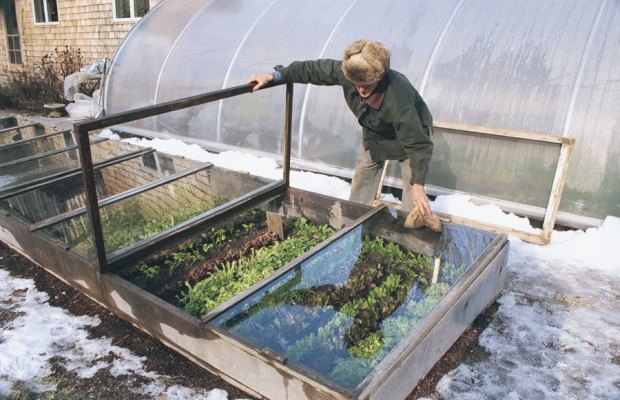When it comes to preparedness – or life in general – there’s a ton to buy. When we can reuse something, it helps. One, there’s the direct cost application. Two, looking at something and seeing its ability to be something completely different has enormous benefits in opening the mind in general.
If we’re preparing for a crisis, gardening and the ability to provide fresh foods in the gulf of winter and spring take on a far greater importance than just a hobby or a passion. Happily, there are some things that can be salvaged for free or found at very low-cost that make a world’s worth of difference. Channel your inner Julie Andrews with me as we look at a few of my favorite things. There’s some non-gardening uses for each listed as well.
DVD Racks
Years ago I picked up a free DVD rack to be a bean trellis for a Rubbermaid tote garden. I have since been in love, and it’s one of the things I consistently watch for at yard sales, curbside pickup listings, and foreclosure cleanup sites.
I got lucky, and mine have a rounded top at the sides. If you find some that don’t, just glue on a milk jug cap for some of its applications.
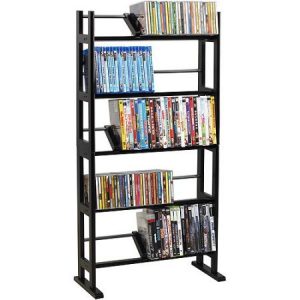 They go way beyond trellising.
They go way beyond trellising.
They work for the far ends and sometimes central support “poles” of low poly tunnels or low hoops for garden beds and rows. A little free bamboo or PVC to span distances, some binder clips (Dollar Tree) to clamp the plastic on, and you’re in business.
They can also be set up long-wise down the middle of a bed to form an A-frame style “camping tent” poly cover if desired, which works really well for peas, with roots and salads to the outer verges, and converts well to later tomato beds.
They also form plant racks for inside near windows, against pale walls, or outdoors to keep salads conveniently close or make use of vertical height.
Mine all hold square plastic coffee tubs (they need a length of string along the front unless it’s a really well-protected area), #2.5 cans (the large tomato or peaches can), and V8 bottles without any modification at all. They’ll hold 2L bottles on their sides for longer, shallow containers, or Lipton and Arizona tea jugs of both types and sizes either cut off vertically or horizontally.
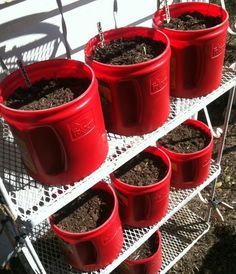
I can do square juice jugs as well, but they overhang enough to make the dog tails an issue on their sides, and I’m more comfortable with some twine or wire looping them to the back bar.
I prefer the open-dowel construction type, just because it leaves me options. I can add thin saplings, bamboo or thin sheathing to convert them if needed, but the open frame allows more light and nestles the rounded-bottom containers well.
Outside Gardening the DVD racks have the ability to hold larger canned goods and bottles of water, be used to dry clothes as-is or be half of a frame of dowels or saplings to create a larger drying space, and the poor kid used to have a pair that were hung with a curtain, topped with a chunk of (free) plywood, and outfitted with $2 in hooks to hang her uniform shirts and pants, like a mini closet that was also the mirror and vanity.
Storm Doors & Windows
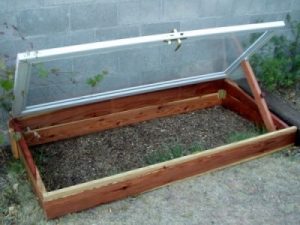
These guys don’t multipurpose to the same degree as the DVD racks. They’re really handy to run across, though. One, having a backup is never a bad thing. Two, they are ready-made cold frames and pest exclusion frames.
I like a 3’ width for garden beds, permanent or bounded, and they fit pretty perfectly as-is. I can tighten up and use straw bales to create a different kind of cold frame with them laid across the top. I can run them in series or as individual structures.
An A-frame can be pretty quickly mocked up and is one of the easiest builds for getting your feet wet. It’s also handy in that it sluices ice and snow build-up and is more resistant to winds. The doors and windows get hinged at the tops, any stick or tool props them so they don’t flip the frame or ka-bong off your noggin, and cats, dogs and goats are less likely to stand on them.
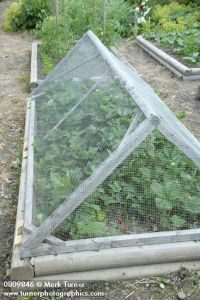
Just the mesh from storm doors and windows is useful. So is mesh that comes off when you repair those.
It’s going in the garden, so some stitching or a little duct tape on both sides to repair a rip isn’t an issue. All it’s doing is protecting seed-stock squash from cross-pollination or keeping creepy-crawlies from eating the brassicas, lettuce, and beans before you can.
The advantage to taking out the mesh is that it’s an even easier build yet. There’s no hinges (unless you hinge the whole frame) and there’s less weight. That means more materials become potentials for the frame itself. You can tie some loops to go around a brick or post, or add some eye hooks to keep it in place.
Do keep the builds small enough that you can lift or flip by yourself once plants are in there. Some posts to the inside of the bed or rows can create a pivot point for flipping.
Painter’s/Construction Drop Cloth
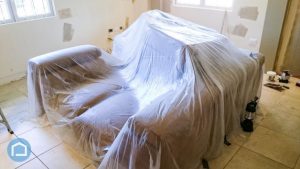
My first set of drop cloth came from a part-time job in high school. I have been in love ever since.
It’s not super expensive, and it’s a toss-up whether the construction poly or the garden poly is cheaper to buy new, but it’s usually the totally clear construction drop cloth in our area. The 5+ mil I use is fairly durable in Southern wind storms, sun rot, ice and freezing rain, and Mid-Atlantic snow.
Contact handyman type businesses and painting businesses – for these as well as the windows and storm doors, and the mesh from those. Usually they’ll only use them for so long and as with the mesh, a few duct tape patches and the paint stains won’t impede too much structurally or light-wise.
Should you see them pop up cheap or free somewhere, don’t neglect those fancy-people outdoor grill, furniture and sofa covers, or any clear, thick, translucent vehicle covers.
Like the totally clear and colorless painter’s plastic, they all make for great garden hoop houses. Some of them can also be outfitted with sturdier construction to form a more permanent greenhouse.
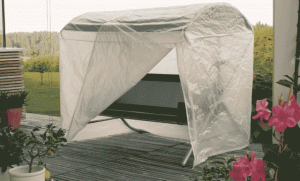
Outside Gardening drop “cloth” or storm doors and windows can also be assembled into wind and snow-blocking shields around exposed doors at the home, or can enclose part or all of a porch to turn into a mudroom in an emergency or during snowy weather. Doing so creates a buffer chamber so there will be less polar vortex entering the house with every human and pet.
Plastic can also be used to cover windows and doors inside or out to decrease drafts and increase insulation value.
The painter’s plastic has the same value for livestock in extreme environments, especially if a normally warm climate is experiencing sudden return-to-winter weather after flocks or rabbits have adjusted to 60s-70s-80s, or if it’s so rare to have severe weather, coops and hutches were never built for extreme cold.
Drop cloths and poly covers can also be used to line bedding for the young, ill and elderly, so that every sneeze and cough or “mommy, I feel- blech” does not lead to disinfecting a mattress as well as changing bedding.
Wire Shelving
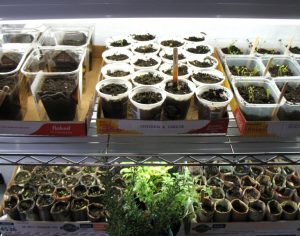
Really, do you ever have enough shelving? I particularly like seeing the simple-frame, open-weave, metal-wire shelving for bathrooms, laundry rooms and closets pop up in junk piles, yard sales, and Craigslist, because it’s super handy, super versatile stuff.
Like the DVD racks, it’s indoor-outdoor tiered plant stands, either year-round or during seed-starting and transplant season(s).
It can also be wrapped in our reclaimed plastic sheets or form part or all of the structure for salvaged windows or poly covers to make a mini greenhouse on a porch, beside a house or garage, for growing later and earlier in the season.
Then it gets even more useful.
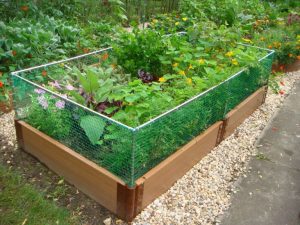
Even if the whole is a little rickety, the shelves themselves can be removed and then turned into trellises. They can be rearranged around their original legs-stand or affixed to bamboo or the legs from old tables or chairs to form short garden fences to discourage turtles and rabbits, and limit dogs running through beds.
As an added bonus, if you have a senior gardener or an injury, sinking some of those sturdy table legs or a bundle of 3-4 larger bamboo canes 18” deep and up to hip or rib level can be a major aid in keeping them gardening.
The sturdy supports can then be covered with netting or sections of storm door mesh to act as a further bird and pest exclusions.
Outside Gardening there are endless uses for shelving, from water collection to organizing anything at all. Wire shelves also offer a lot of airflow for drying clothes.
The shelf “planks” of wire units can be used to patch and shore up fences and coops, especially somewhere something dug. They can be used to cover vehicle and house windows to limit damage from thrown bricks or if a storm window is damaged during a crisis.
They can also be reconfigured into a cage or crate for rabbits or small birds, to expand flocks or because they happened to be stacked from Craigslist and Freecycle runs ahead of time and now there’s a puppy to crate train or weather has shifted and we’re worried about the next generation of layers.
The shelves can be used to sift the largest chunks out of compost or soil in some cases, help form a gabion to slow water and keep it from increasing erosion, or can be lined with mesh or cloth for drying foods or seeds.
The shelves can usually be easily reconfigured with larger or smaller gaps than originally intended to facilitate buckets, larger boxes, or drying seeds and grains.
They don’t pop up as much as they used to, but some can still be found on the freebie sites as curbside pickup, or for <$15-20. They also sometimes pop up at Salvation Army/Goodwill, and if you cultivate contacts, sometimes you get your hands on just the shelf parts because the rest of the racks have been lost during multiple transfers or all the pieces weren’t donated.
Garden Reuse-its – My Favorite Things
These are just a few of my favorite things to re-purpose for growing veggies. The world is full of things like laundry bags we can use to prevent caterpillars and squash bugs on our cabbage and beans and zucchini, and old carpeting we can layer deep in garden walkways to cut down on maintenance time.
Any time we can reuse something, it cuts down on waste, making for a better world – not just the world around us. If we’re saving time and money, and if we’re developing some creativity and a new way of looking at things, we increase our preparedness and better our own world directly .
Source : R.Ann Paris

